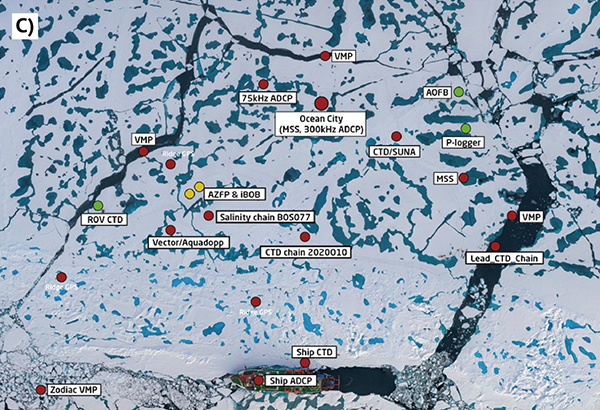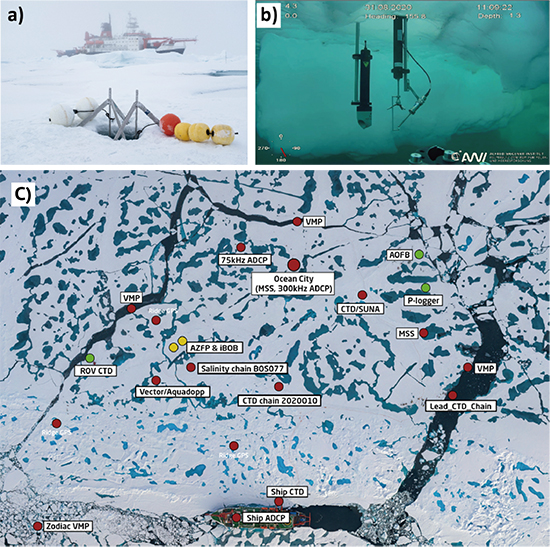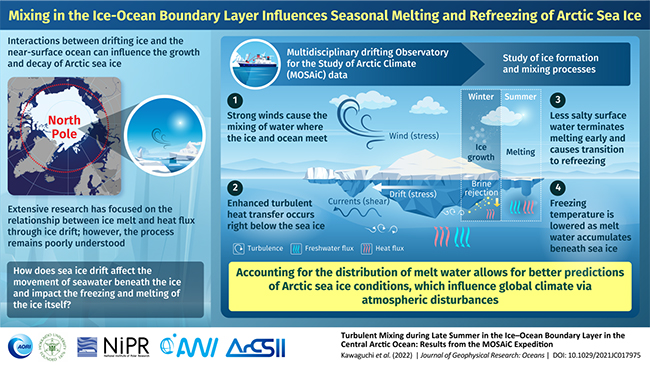Getting to The Bottom of The Arctic Sea Ice Decline: Investigation of Heat Movement near The North Pole and Under the Arctic Sea Ice
6 September, 2022
Yusuke Kawaguchi (Atmosphere and Ocean Research Institute, The University of Tokyo)

Sea ice levels in the Arctic Ocean are rapidly declining, thanks to global warming. Now, to understand and forecast the growth and decay of the ice, we conducted a survey in the Arctic Ocean to investigate the influence of ocean heat on sea ice in the ice-ocean boundary layer. Our findings provide insights into the mechanisms of Arctic sea ice decline for making accurate predictions in the future regarding the global climate.
The sea ice (a term for ice that is not attached to the shoreline) in the Arctic Ocean is currently at an all-time low, owing to global warming. Scientists have previously attempted to study the ice in this region; however, owing to its constant shifting by strong surface winds and ocean currents, it is difficult to monitor continuously.
The growth and decay of the sea ice can be influenced by the interaction of the drifting ice and the near-surface ocean layer, where turbulent heat and salt fluctuations govern the formation of ice. Turbulence at the ice-ocean boundary layer (IOBL), which is the transition zone between the sea ice and seawater, is also shaped by the intrusion of fresh water from melting sea ice and the physical exclusion of brine during ice formation. While some research has been conducted on the mechanisms of sea ice formation, the combined effect of mechanical and buoyancy-driven forces on this process remains poorly understood.
We have utilized data collected during the international ship-based MOSAiC observational expedition, to examine the Arctic IOBL as it transitioned from melting to refreezing in real time. We believe that owing to the complex patterns of heat and energy transfer, the physics of the cold oceans is complicated. Our objective was to quantify the thermodynamic growth and decay of the sea ice while incorporating effects of heat and salt exchange with near-surface water due to turbulent forces.
The findings have been published in the Journal of Geophysical Research-Oceans![]() . This paper was made available online on July 20 in 2022 and was published in Volume 127 Issue 8 of the journal on 19 August 2022.
. This paper was made available online on July 20 in 2022 and was published in Volume 127 Issue 8 of the journal on 19 August 2022.
We combined various datasets, including observations of air, sea ice, and ocean properties from the ice floe. These were collected during the final leg of the MOSAiC study, which was an international project undertaken to study the climate, ocean, and sea ice characteristics of the Arctic Ocean.
From the survey, we concluded that the present Arctic sea ice was more prone to melting in summer and to freezing in autumn and early winter than before. When probed on the main findings, we believe about the characteristics of seawater and sea ice that drive this fascinating phenomenon –– our first discovery was that in the summer, strong winds cause the mixing of water where the ice and ocean meet. We were able to show that enhanced heat transfer occurs right below the sea ice.
Our second finding concerns the drop in the salinity of the seawater as it mixes with the meltwater from the sea ice. As melt water accumulates beneath the sea ice, salinity of sea water decreases and then the freezing temperature increases. This terminates the melting of sea ice at an earlier timing because water gets easier to freeze.
We are excited by the implications their findings have on the field of polar oceanography, particularly in the context of climate change. Presently, the team is developing a device that simultaneously measures sea ice movement and salinity at the IOBL, with the hope that it will capture more data to paint a clearer picture of the fluctuations in the Arctic sea ice.
We would like to conclude that the extent of the Arctic sea ice may affect the regional climate in distant places, like Japan, via atmospheric disturbances. We also believe that studying the sea ice will allow us to better predict future changes in the Earth’s climate.
Images
Figure 1

Image Title: View of the MOSAiC observation taken in September 2020.
Caption:
Photos a) and b) show the observation equipment used in this study. They were taken from the ice and underwater, respectively.
Photo c) shows the arrangement of the observation stations, taken from a helicopter looking downward. Here, the white, light blue, and dark blue areas are sea ice (or snow), melt ponds, and leads (areas of exposed sea surface), respectively. The icebreaker Polarstern is moored at the bottom of the photo, and a number of observation stations are located on the ice sheet in the center of the photo.
Image Credit: Alfred Wegener Institute, Germany
License type: Original content
Figure 2

Image Title: Ice formation influenced by mixing and turbulence in Ice-Ocean Boundary Layer
Caption: In a recent study, researchers from Japan examine the different physical phenomena that influence the formation and melting of sea ice in the Arctic Ocean
Image Credit: Yusuke Kawaguchi, Atmosphere and Ocean Research Institute, The University of Tokyo
License type: Original content
Reference
Title of original paper: Turbulent Mixing during Late Summer in the Ice–Ocean Boundary Layer in the Central Arctic Ocean: Results from the MOSAiC Expedition
Journal: Journal of Geophysical Research – Oceans
DOI: 10.1029/2021JC017975
Funding information
This study was supported by funding through MEXT, Japan Society for the Promotion of Science via Grant Numbers: JP18H03745, JP18KK0292, JP17KK0083, JP17H04715, JP20H04345, JP22H01296, and the Arctic Challenge for Sustainability II (ArCS II): JPMXD1420318865. Funding also received from Bundesministerium für Bildung und Forschung via Grant Numbers: N-2014-H-060_Dethloff, 03F0810 A, 03F0804 A.
Media contact Yusuke Kawaguchi
Email: ykawaguchi[at]aori.u-tokyo.ac.jp
![]()



